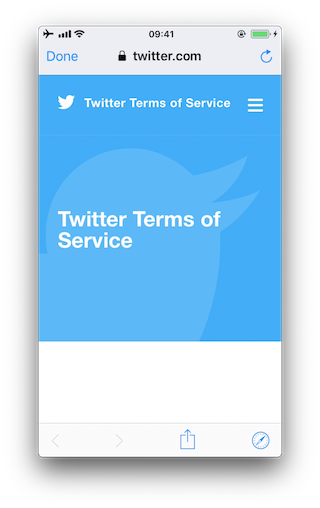MASTG-KNOW-0076: WebViews
WebViews are in-app browser components for displaying interactive web content. They can be used to embed web content directly into an app's user interface. iOS WebViews support JavaScript execution by default, so script injection and Cross-Site Scripting attacks can affect them.
Types of WebViews¶
There are multiple ways to include a WebView in an iOS application:
UIWebViewWKWebViewSFSafariViewController
UIWebView¶
UIWebView is deprecated starting on iOS 12 and should not be used. Make sure that either WKWebView or SFSafariViewController are used to embed web content. In addition to that, JavaScript cannot be disabled for UIWebView which is another reason to refrain from using it.
WKWebView¶
WKWebView was introduced with iOS 8 and is the appropriate choice for extending app functionality, controlling displayed content (i.e., prevent the user from navigating to arbitrary URLs) and customizing.
WKWebView comes with several security advantages over UIWebView:
- JavaScript is enabled by default but thanks to the
javaScriptEnabledproperty ofWKWebView, it can be completely disabled, preventing all script injection flaws. - The
JavaScriptCanOpenWindowsAutomaticallycan be used to prevent JavaScript from opening new windows, such as pop-ups. - The
hasOnlySecureContentproperty can be used to verify resources loaded by the WebView are retrieved through encrypted connections. WKWebViewimplements out-of-process rendering, so memory corruption bugs won't affect the main app process.
A JavaScript Bridge can be enabled when using WKWebView and UIWebView. See Section "Native Functionality Exposed Through WebViews" below for more information.
SFSafariViewController¶
SFSafariViewController is available starting on iOS 9 and should be used to provide a generalized web viewing experience. These WebViews can be easily spotted as they have a characteristic layout which includes the following elements:
- A read-only address field with a security indicator.
- An Action ("Share") button.
- A Done button, back and forward navigation buttons, and a "Safari" button to open the page directly in Safari.

There are a couple of things to consider:
- JavaScript cannot be disabled in
SFSafariViewControllerand this is one of the reasons why the usage ofWKWebViewis recommended when the goal is extending the app's user interface. SFSafariViewControlleralso shares cookies and other website data with Safari.- The user's activity and interaction with a
SFSafariViewControllerare not visible to the app, which cannot access AutoFill data, browsing history, or website data. - According to the App Store Review Guidelines,
SFSafariViewControllers may not be hidden or obscured by other views or layers.
This should be sufficient for an app analysis and therefore, SFSafariViewControllers are out of scope for the Static and Dynamic Analysis sections.
Safari Web Inspector¶
Enabling the Safari Web Inspector on iOS allows you to remotely inspect the contents of a WebView from a macOS device. This is particularly useful in applications that expose native APIs using a JavaScript bridge, such as hybrid applications.
The Safari Web Inspector requires apps to have the get-task-allowed entitlement. The Safari app has this entitlement by default, so you can view the contents of any page loaded into it. However, applications installed from the App Store will not have this entitlement and cannot be attached. On jailbroken devices, you can add this entitlement to any application by installing GlobalWebInspect. Then, you can attach Safari on your host to examine the contents of the WebView (see Attach to WKWebView).
Native Functionality Exposed Through WebViews¶
In iOS 7, Apple introduced APIs that allow communication between the JavaScript runtime in the WebView and the native Swift or Objective-C objects. If these APIs are used carelessly, important functionality might be exposed to attackers who manage to inject malicious scripts into the WebView (e.g., through a successful Cross-Site Scripting attack).
Both UIWebView and WKWebView provide a means of communication between the WebView and the native app. Any important data or native functionality exposed to the WebView JavaScript engine would also be accessible to rogue JavaScript running in the WebView.
UIWebView:
There are two fundamental ways of how native code and JavaScript can communicate:
- JSContext: When an Objective-C or Swift block is assigned to an identifier in a
JSContext, JavaScriptCore automatically wraps the block in a JavaScript function. - JSExport protocol: Properties, instance methods and class methods declared in a
JSExport-inherited protocol are mapped to JavaScript objects that are available to all JavaScript code. Modifications of objects that are in the JavaScript environment are reflected in the native environment.
Note that only class members defined in the JSExport protocol are made accessible to JavaScript code.
WKWebView:
JavaScript code in a WKWebView can still send messages back to the native app but in contrast to UIWebView, it is not possible to directly reference the JSContext of a WKWebView. Instead, communication is implemented using a messaging system and using the postMessage function, which automatically serializes JavaScript objects into native Objective-C or Swift objects. Message handlers are configured using the method add(_ scriptMessageHandler:name:).